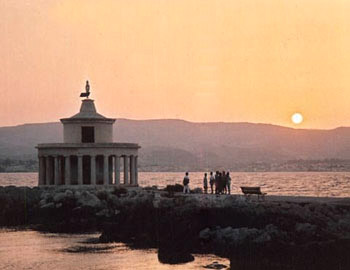
Island of Seafarers
by W. Ruth Kozak
When Juan de Fuca sailed his ship up the Pacific coast of western Canada, into the Straits now named for him, I wonder if he felt a pang of homesickness for his native home, Kefalonia, Greece.
Juan de Fuca, whose real name was Iannis Focus, was born in Kefalonia during the reign of the Venetians in 1550, and later went to sea in the service of Spain, on a quest to find the passage that links the Pacific and Atlantic Oceans. When his expedition failed, the King of Spain refused to pay him, so he returned to this island paradise to live out the rest of his life.
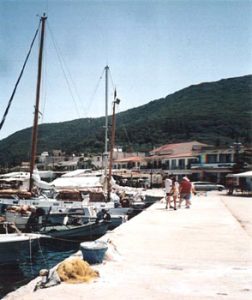 I went on an expedition of my own to explore Juan de Fuca’s island. My voyage took me by ferry from Patras to the little port of Sami and by bus to Argostoli, the modern capital, a pretty town with a harbor esplanade lined with yachts and fishing vessels.
I went on an expedition of my own to explore Juan de Fuca’s island. My voyage took me by ferry from Patras to the little port of Sami and by bus to Argostoli, the modern capital, a pretty town with a harbor esplanade lined with yachts and fishing vessels.
A devastating earthquake flattened most of Kefalonia’s villages in 1953 including all the elegant buildings that used to grace Argostoli. The new town has been rebuilt in the unique Venetian style, the soft pastel buildings giving the impression of a water-color painting. On the main street there’s a museum exhibiting pictures of the town before and after the quake.
As I hiked along the windy shoreline to the Fenari, a replica of a Venetian lighthouse, I was greeted by the friendly locals. Both English and Italian are spoken here, and you can count on the island folk to strike up a conversation.
The wind gusted and howled, churning the Bay with whitecaps. As I watched a little ferry boat tossed like balsa wood as it struggled against the waves, I was reminded of the ‘iron gray sea’ described by Homer in The Odyssey. This island was once part of Odysseus’ kingdom.
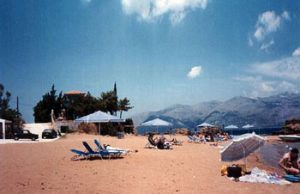 From antiquity until the present, Kefalonians have been masters of the sea. Much of the island’s coastline is rugged with steep limestone cliffs that plunge into the sea and miles of white and red sand beaches.
From antiquity until the present, Kefalonians have been masters of the sea. Much of the island’s coastline is rugged with steep limestone cliffs that plunge into the sea and miles of white and red sand beaches.
I took a bus trip to explore the island. The road spirals up the cedar and pine-covered mountainsides winds past villages of stone-built houses tucked in the protective folds of the mountains. Along the route, you see the ruins Venetian fortresses and castles.
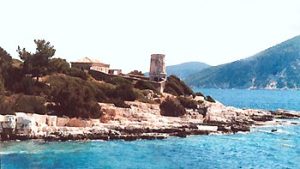 Kefalonia is known for its unique forest of rare fir trees called Abies Cefalonica. The air is redolent with the fragrance of sage, thyme, bayleaf and oregano. Tall cypresses stand straight and elegant, their dark green a contrast to the silvery olive trees. Did Juan de Fuca feel nostalgic for his island homeland as he cruised the Pacific Northwest Coast? Our coastal islands enjoy a Mediterranean micro-climate similar to Kefalonia. Herons, kingfishers and gulls swoop from the rocky cliffs. There are more than a thousand species of plants on Kefalonia, some very rare, including fifty species of wild orchids.
Kefalonia is known for its unique forest of rare fir trees called Abies Cefalonica. The air is redolent with the fragrance of sage, thyme, bayleaf and oregano. Tall cypresses stand straight and elegant, their dark green a contrast to the silvery olive trees. Did Juan de Fuca feel nostalgic for his island homeland as he cruised the Pacific Northwest Coast? Our coastal islands enjoy a Mediterranean micro-climate similar to Kefalonia. Herons, kingfishers and gulls swoop from the rocky cliffs. There are more than a thousand species of plants on Kefalonia, some very rare, including fifty species of wild orchids.
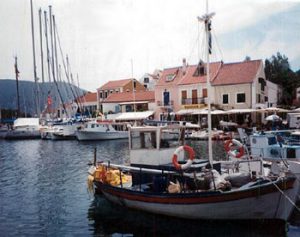 Time seems to have erased the village of Valeriano where Juan de Fuca was born, but on a rocky promontory at Fiskardo, once the hideaway of renegade pirates, I explored the ruins of a Venetian castle that commanded the entrance to Fiskardo’s harbor. As I watched the fishing kaikis and yachts ply the narrow channel that separates Kefalonia from the rugged, mountainous shores of nearby Ithaka, Odysseus’ island, I could not help but think of all the mariners who have ventured from these shores, especially Juan de Fuca, the Kefalonian who sailed to the Pacific Northwest. Our journeys have spanned each others worlds.
Time seems to have erased the village of Valeriano where Juan de Fuca was born, but on a rocky promontory at Fiskardo, once the hideaway of renegade pirates, I explored the ruins of a Venetian castle that commanded the entrance to Fiskardo’s harbor. As I watched the fishing kaikis and yachts ply the narrow channel that separates Kefalonia from the rugged, mountainous shores of nearby Ithaka, Odysseus’ island, I could not help but think of all the mariners who have ventured from these shores, especially Juan de Fuca, the Kefalonian who sailed to the Pacific Northwest. Our journeys have spanned each others worlds.
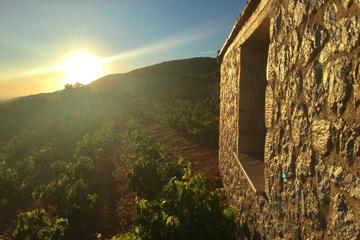
Private Tour: Kefalonia Wine Discovery with Gastronomic or Picnic Lunch
If You Go:
Buses leave the Kifissou St. depot in Athens several times a day for the ports of Sami, Argostoli, Lixour and Poros, via the ferry from Patras. The trip takes about eight hours.
An island bus provides service to any of the scenic villages and beaches on Kefalonia.
Accommodation is available in a variety of hotels and pensions. There are camp sites located at Argostoli and Sami.
About the author:
W. Ruth Kozak has spent a great deal of time in Greece either visiting or living there, since her first visit in 1979. She has traveled all around the country and visited many of the islands. Being from British Columbia, Canada, she had a special interest in Kefalonia when she learned that Juan de Fuca (actually named Iannis Focus) originated from the island. Since her first visit there she has returned several times and recommends it as a destination for travelers to Greece.
All photos are by W. Ruth Kozak.



Leave a Reply
You must be logged in to post a comment.